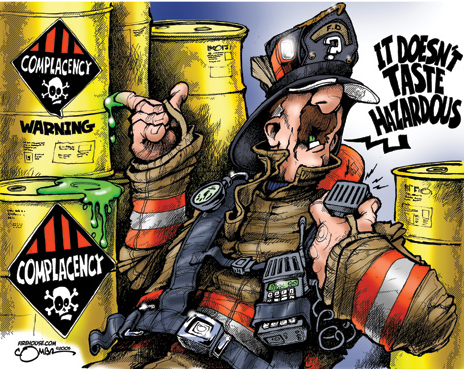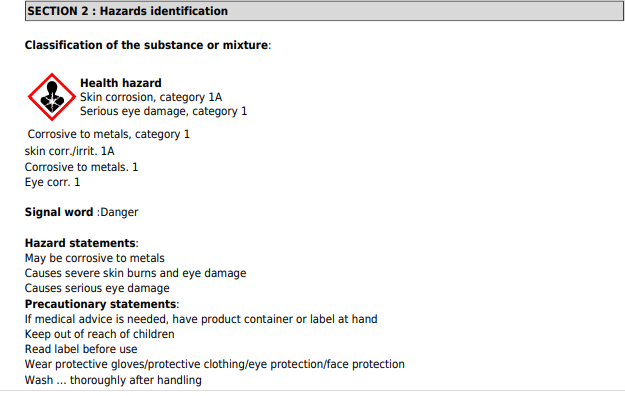21 Days: Hazards for materials containing reportable EHS’s
It’s a “both and” situation
(No disrespect meant to firefighters and first responders)
(True story from my early days at a mile-square auto plant, built in 1918, we plated 12,000 car bumpers per day, Copper, Copper Cyanide Strike, Nickel, Chrome. )
“You could tell the concentration of the cyanide bath by how sweet your cigarette tasted”.
That’s what I was told by a foreman who had been working on the plating line for 30 years (how many wrong things can you get in one sentence?)
Back to Tier2…
For Extremely Hazardous Substances that are also present in mixtures, there are several things to consider:
For Extremely Hazardous Substances that are reportable (have exceeded their Threshold Determinations of 500 pounds or the Threshold Planning Quantity, whichever is less, across all materials containing the EHS at the facility), you might want to obtain an SDS for the EHS itself, which will tell you the hazards associated with the EHS. An example is Sulfuric Acid for batteries (if you have a laboratory that uses Sulfuric Acid or a wastewater treatment plant or other water treatment operations that use Sulfuric Acid, you may already have an SDS for pure Sulfuric Acid) (below is an exerpt from a Safety Data Sheet for Sulfuric Acid showing the Hazard section)
Exerpt from Sulfuric Acid Safety Data Sheet showing hazard section (partial)
If you are reporting for mixtures (tradenames) as a whole as opposed to constituents (which has been my assumption throughout this series of blog posts because it is by far the most useful for emergency responders), You are required to report any material/product/tradename which contains that EHS (in our example here, Sulfuric Acid). Look at the Safety Data Sheet SDS for the mixture/product/tradename that contains the Extremely Hazardous Substance and see what hazards the SDS shows. If the concentration of the EHS is sufficiently low, the mixture/product/tradename may not exhibit the hazard of the pure EHS
If you believe the SDS hazards are correct, use those as your guidance and report hazards on your Tier2 report accordingly.
If you believe the SDS information is deficient, try to get better information. One example in this case, although not definitive, would be to look at the pH of the mixture as a whole (Section 9). You can also see if DOT Shipping information is provided—if the DOT Hazard Class is indicated as Corrosive, you would want to report that hazard. If not sure, you may want to include the hazard for the EHS in its pure state, if you think the hazard might exist.
More tomorrow, here’s to March 2nd!
If you need help finishing up your Tier2 activities, feel free to reach out to me at manguardehs at gmail dot com
Community outreach: What examples do you have where a mixture containing a reportable EHS did not exhibit the hazard(s) of the pure EHS?
#SARA312 #SARATierII #SARATier2 #EPCRA #EGLE #March1EPAReportDeadline #Hazards #GHS #Crosswalk #SDS #SDSSection2 #EHS #ExtremelyHazardousSubstances
Michigan Environment, Great Lakes, and Energy EGLE links from all three 2022 SARA 312 virtual training course webinars:
I’m reposting these links with my daily Tier2 post because they are so useful.
You can sign in and watch/listen even if you didn’t sign up for the webinar series.
RECORDING LINK FOR SESSION 2: Wed Jan 19, 2022.
Really good example on batteries. This is the “in the weeds” how to conduct your threshold determinations episode: https://attendee.gotowebinar.com/recording/4027906237723673347
I talked to Mike Young, one of the presenters, right after the first webinar. He said that it’s not unusual for them to take phone calls from people from other states (with the warning to confirm that your state doesn’t have differences in their requirements compared to Michigan).
RECORDING LINK FOR SESSION 1:
https://attendee.gotowebinar.com/recording/7957790593170499843
Michigan uses Tier2 Manager for report submission, which is a Michigan-specific program. If your state uses different software, you will need to review its specific requirements.
RECORDING LINK FOR SESSION 3:
https://attendee.gotowebinar.com/recording/2763075340284995085
If your state uses a different software program there may be some differences, but this webinar will probably also cover how to determine the Hazard Ratings, how to enter Locations, and other details associated with report submission. I’ll post the replay when it becomes available.
PRESENTATION: (I wasn’t able to attach a copy of the presentation, email the link below and they will send it to you)
SARA TITLE III – TIER II REPORTING WEBSITE: http://www.michigan.gov/sara
MICHIGAN FACILITIES’ GUIDE TO SARA TITLE III: https://www.michigan.gov/documents/deq/deq-oea-saraguidebook_509720_7.pdf
CONTACT INFORMATION:
Mike Young and Adam Pohl
517-284-7272

